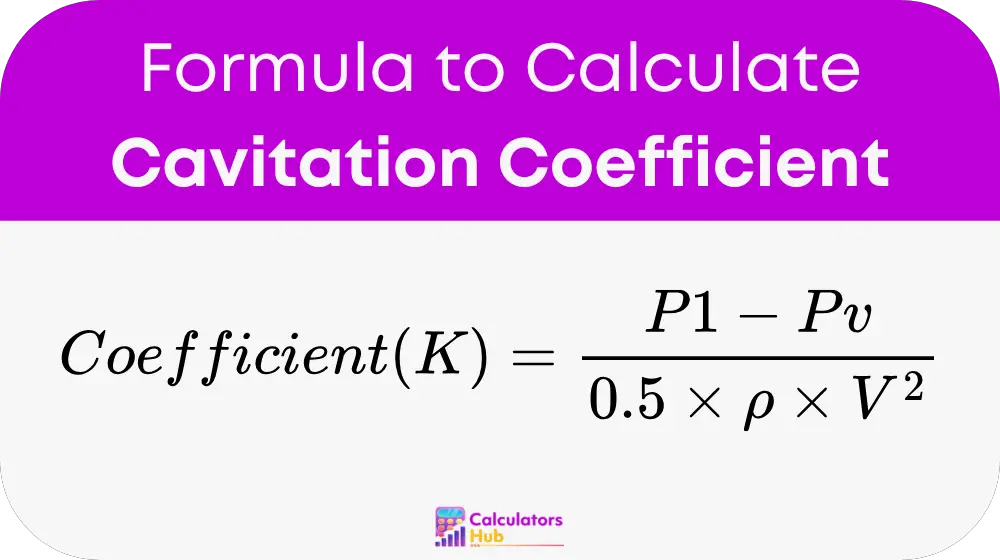Cavitation is a phenomenon in fluid dynamics where rapid changes in pressure cause the formation of vapor bubbles within the liquid. These bubbles can collapse with violent force, causing damage to equipment such as pumps, propellers, and turbines. Understanding cavitation is essential for engineers and fluid mechanics professionals to prevent this issue and ensure the longevity and efficiency of fluid systems.
The Cavitation Coefficient Calculator is a tool designed to help professionals quickly and accurately calculate the cavitation coefficient, a critical parameter in evaluating the potential for cavitation. The cavitation coefficient helps assess the likelihood of cavitation occurring by considering factors such as pressure, fluid density, and velocity at a given point. By using this calculator, you can estimate whether the system operates within safe conditions or if the likelihood of cavitation is too high.
Formula of Cavitation Coefficient Calculator
The formula for calculating the cavitation coefficient (K) is:

Where:
- K = Cavitation coefficient (dimensionless), which helps quantify the potential for cavitation.
- P1 = Inlet or upstream pressure of the fluid (in pascals or psi), representing the pressure at the point where the fluid enters a system.
- Pv = Vapor pressure of the fluid at the given temperature (in pascals or psi), representing the pressure at which the fluid turns into vapor at a specific temperature.
- ρ = Density of the fluid (in kg/m³), which is the mass of the fluid per unit volume.
- V = Velocity of the fluid at the point of interest (in m/s), which affects the pressure and cavitation potential.
This formula is essential for determining the safety of fluid systems, helping engineers predict whether cavitation could occur and cause damage. A higher cavitation coefficient generally indicates a lower risk of cavitation.
General Terms for Cavitation Coefficient Calculations
To assist users in understanding cavitation and related concepts, here is a table with common terms associated with cavitation coefficient calculations:
| Term | Definition |
|---|---|
| Cavitation | The formation and collapse of vapor bubbles in a fluid due to pressure changes. |
| Cavitation Coefficient | A dimensionless number that helps determine the likelihood of cavitation. |
| Inlet Pressure (P1) | The pressure of the fluid as it enters a system or device, typically in pascals or psi. |
| Vapor Pressure (Pv) | The pressure at which a liquid turns into vapor, dependent on the fluid's temperature. |
| Density (ρ) | The mass of the fluid per unit volume, usually in kg/m³. |
| Fluid Velocity (V) | The speed at which the fluid is moving, usually in meters per second (m/s). |
| Cavitation Damage | The physical damage caused by the collapse of vapor bubbles in fluid systems. |
| NPSH (Net Positive Suction Head) | A measure used to determine the likelihood of cavitation occurring in pumps. |
This table provides quick reference terms related to cavitation and fluid mechanics, which can be useful when calculating the cavitation coefficient or analyzing fluid systems.
Example of Cavitation Coefficient Calculator
Let’s go through an example to demonstrate how to use the cavitation coefficient formula.
Suppose we have the following values for a fluid system:
- P1 (Inlet Pressure) = 200,000 Pascals (Pa)
- Pv (Vapor Pressure) = 2,000 Pascals (Pa)
- ρ (Fluid Density) = 1,000 kg/m³
- V (Fluid Velocity) = 10 m/s
We can now use the cavitation coefficient formula to calculate the value of K:
Cavitation Coefficient (K) = (P1 - Pv) / (0.5 * ρ * V²)
Substitute the known values:
K = (200,000 - 2,000) / (0.5 * 1,000 * (10)²)
K = 198,000 / 50,000 = 3.96
This result means that the cavitation coefficient for this system is 3.96. If the cavitation coefficient is too low, cavitation is more likely to occur, and engineers may need to adjust system parameters to prevent damage.
Most Common FAQs
Cavitation is the formation and collapse of vapor bubbles in a fluid due to changes in pressure. It can cause significant damage to mechanical equipment. Calculating the cavitation coefficient helps engineers assess whether cavitation is likely to occur and take preventive measures to avoid damage.
To reduce cavitation risk, you can increase the inlet pressure, reduce fluid velocity, or select fluids with lower vapor pressures. The cavitation coefficient is useful in assessing these parameters to ensure safe system operation.
Yes, the cavitation coefficient formula applies to any fluid, but the specific values of the fluid's vapor pressure, density, and velocity must be considered. Fluids with low vapor pressures or high velocities are more prone to cavitation, requiring careful system design.